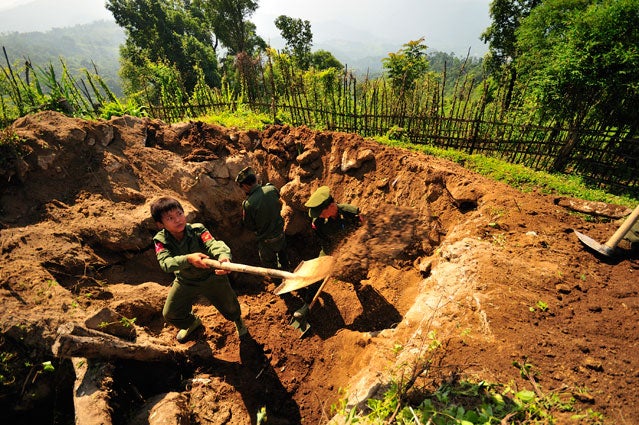In early December, U.S. Secretary of State Hillary Clinton met with Burmese Presiden Thein Sein in the country’s capital of Naypyidaw. No senior American leader had travelled to the country in 50 years, but after decades of military rule the Myanmar government has instituted a series of liberalizing reforms since allowing elections in March. “Today,” Clinton said, “the United States is prepared to respond to reforms with measured steps to lessen its isolation and improve the lives of citizens.”
News reports of liberalization have largely ignored a humanitarian crisis in northern Burma: even as the Burmese government has released hundreds of political prisoners, the Burmese army has waged war and committed atrocities against ethnic Kachin civilians.
The Burmese who live in southern Burma are one of 136 recognized ethnicities in the country. Ethnic Burmese comprise roughly half the population and control half of Burma’s territory. In the rest of the country, though, unrecognized and semi-autonomous indigenous groups are in power.
Foremost among these groups are the Kachin. They control all of northern Burma, an area the size of Maine that is wedged between India and China. The Kachin number close to one million, speak their own language, and are overwhelmingly Christian. Their territory was ceded to Burma following World War II, and for 22 years the Kachin Independence Army fought a bloody guerrilla war against the Burmese government. A ceasefire signed in 1994 fell apart on June 9, and fighting resumed.
I spoke with Ryan Libre, an award-winning American photojournalist based in Thailand, on December 1. Ryan has covered the Kachin for four years and is now finishing work on a documentary about their struggle. A preview can be seen at . He is currently based in the town of Laiza, close to the fighting, and spoke with me on a cell phone that was connected to a Chinese cell tower across the border.
What’s the level of disruption in Kachin right now?
Huge. The Burmese have lost hundreds of people. The KIA has lost fewer, but their hospitals are overflowing. There are . All the bridges that connect this part of the country have been blown up.
Are you aware human-rights abuses committed by either side?
There are many of Burmese soldiers raping and killing Kachin girls and women. I met one farmer in the refugee camp whose wife was raped and killed. I’ve seen images of villages burned down.
When did the fighting start up?
June 9. I came three days later. Everyone was worried and excited. There was no sleep. People were working around the clock. It was war fever. All the kids in town were dressed up in KIA uniforms.
What triggered it?
Officially, the Burmese Army was sent into a dam construction area and the fighting started accidentally. But I think it was planned in advance by the Burmese government, to clear the KIA out of North Shan state, where the Chinese oil pipeline will pass.
Is there still active fighting?
Yes. Every day there are at least small battles, and often large ones. It’s front-line jungle fighting. The KIA has small outposts on strategic hills, and there are daily attempts by the Burmese army to take them over. There’s lots of big artillery from the Burmese side, because that’s an area where they have a big advantage over the KIA.
In your opinion, the Burmese are the aggressors?
Yes. I was at a peace talk where the Burmese said, “Let’s stop fighting,” and the KIA said, “Well, that’s easy, just stop sending your troops into our territory.” But the Burmese keep pushing more and more into land that is Kachin territory, according to the terms of the ceasefire agreement that was signed in 1994.
How did the situation start?
At the end of World War II, the British had a mandate to leave the colonies in this area. The big question was whether Kachin State would be an independent country, which it was before the British came. When the British were pulling out, Aung San, Aung San Suu Kyi’s father, approached the Kachin and said let’s make one country that will be much stronger than either individually. It was heavily debated. Most Kachins were not in favor of it, but their leader ended up signing it.
In 1947, Aung San was assassinated after signing the agreement but before he finished writing the first Burmese constitution. When the constitution was finished, it had none of the rights that the Kachin had agreed to. The KIO/KIA formed in 1961.
Do the Kachin want to become an independent country now?
Even though they’re called the Kachin Independence Army, very few want full independence. They want the level of autonomy that was promised to them. A level that would be like a U.S. state. They want to be part of an actual union, but they want control over their own education—they want to be able to teach their history—and their natural resources and land.
And they have resources to work with?
A lot. They have essentially all of the world’s high-quality jade. They have rare earth minerals. But the really big thing now is hydropower, which Burma, India, and China all want and need. Kachin is right at the base of the Himalayas with deep canyons that are glacial-fed and ideal for hydropower.
But didn’t the government just stop China from moving forward with the Myitsone Dam?
I have been told that it was put on hold for a while ago anyway, for financial reasons. I don’t think it is because the government suddenly decided to start listening to its people.
Will Hillary Clinton be meeting with anyone from the KIO?
Definitely not.
What is your focus right now?
Lately I’ve been staying at the refugee camp, which is not getting any international or United Nations aid.
Why are you staying in the camp?
A lot of what I want to do with photography is to go beyond that one-hour trip to the camps. When you actually spend the night somewhere, and wake up in the morning with the refugees, it changes everything. I’m excited to see what kind of photos and videos come out of that.
How did you first get involved with the Kachin?
I met a Kachin activist in Thailand. I called her Burmese, and she said, ‘Hey, I’m not Burmese, I’m Kachin.’ I tried to do research about the Kachin and found nothing. Literally nothing. The most current articles about the Kachin were ten, fifteen years old. A few months later I met another Kachin who was part of the KIO. He invited me to visit. Then I got a grant from the Pulitzer Center for Crisis Reporting to come for a month. The story was amazing and under reported.
And you’re hoping to change that with your documentary?
Yes. It’s called “Portraits of Independence.” I’m hoping to get a shortened version of it out to film festivals in February. I would never have thought to do video, but just before coming here I’d bought a Nikon D90, which had built-in video. So I thought, okay, I’ll take some video after I have a shot framed. When I saw it played back—especially the interviews, people telling their own stories—I realized the power of that medium. So I started devoting more of my time to video. I’m really excited about it. I can tell a lot of the story in a way that the mass media is never going to come close to. I’ve been shooting for four years and have tons of very good footage. It’s just a matter of sitting down with an editor and putting it together. It’s going to be a huge effort. It’s pretty difficult for someone to wrap their head around what’s happening in Kachin. I hope the website and documentary help.


